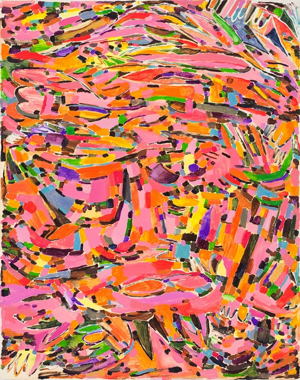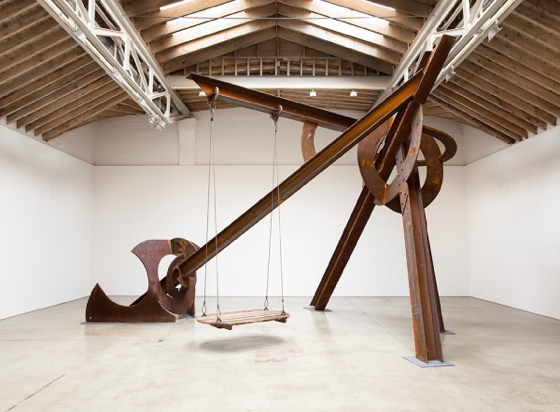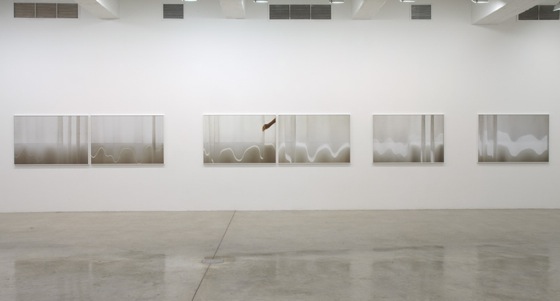In an effort to cover more art before shows close, AFC decided to visit a handful of galleries and report what we saw. More than usual, I wanted to stay longer. Here are my notes from five shows at Mitchell-Innes & Nash, Mixed Greens, Paula Cooper, and Tanya Bonakdar.
We started at Mitchell-Innes & Nash for the group show of painting and sculpture “December”. Howie Chen has organized 17 works, mostly from 2011, all from fairly well-known artists who work in a similar vein; the list includes Cheryl Donegan, Jessica Stockholder, Lucky Debellevue, Adam Putnam, and Jean Dubuffet.
Immediately upon entering, you’re confronted by Ian Cheng's “Bigger Than Your Blog,” a fourteen-foot-tall reflective sheet leaning against the back wall. On it is a drunkenly spray-painted orange paragraph, beginning with: “ohm y god big words, : feel dumb,” ending with “someone laughed so I'm laughing too my clothes — clayton deutsch.” This is more or less the sensibility shared by all members of the show: work that is weird, elementary, apparently naïve, but not stupid. They more react to academic elitism and our expectations of art.
There are themes and pairings; Cheryl Donegan's plexi with swipes removed from black paint mimics Tony Matelli's mirrored plexi with what look like finger swipes removed from dust. (Aside: An interview with Howie Chen reveals them to be the product of an extensive process involving computer drawings, wax resist, and auto paint. The point of this, he remarks, “…is the person or the humanity in the thing. It's not time passing that's interesting, it's the effect of time on the human mark that's important.”)
Materials and forms are often unconventional, such as Margaret Lee's plastic potato tacked chest-level to the wall, next to Jean Dubuffet's small twisted cork knot titled “Sorcière.” This is becoming a common art language: halting mid-sentence or production, before the image or sculpture is a definitive, closed thing. Here it fosters an openness through tactful choices in materials, placement, and timing.
Next we saw Howard Fonda's bright-colored, three-and-four foot tall, orangey pink and blue-green abstract rectangular oil paintings at Mixed Greens. Swimming medleys of thumb-like Starburst and forest-colored paint strokes are arranged like horizontal Dominoes, interspersed with little gaps of light-toned canvas, which sometimes forms outlines. From afar, one notices that most of his paintings are structured as cartoony faces, masked up close by their tapestry-like patterns. As a painter, these are a guilty pleasure.
Mark di Suvero has installed an enormous reddish-steel sculpture supporting a flat, four-person wooden swing in the massive back gallery of Paula Cooper. Similar to much of di Suvero's previous work, it looks as though the top beam of a giant swingset had collapsed, so that it extends from the floor to the upright righthand support. Both points of intersection are encircled by cosmic, rotated loops of steel, six to eight feet in diameter. From the swing, you see only the similar, smaller (maybe six foot tall) steel sculpture in the front room, cut out from steel sheeting; a fish or wing-like cut-out is suspended through an abstracted square and curved hole. Swinging, watching your own reflection in the gallery window, produces the feeling of being in a fishbowl or cradled by giant arms. This is a good feeling, as is floating in a pool of water or sliding down a slide; this seemed to be the point, too, of his large-scale abstract painting filled with yellow, orange, red, green, and purple waves of ribbony strokes in the front room.
Tanya Bonakdar, though, was most satisfying. On the first floor, Uta Barth's inkjet prints of light are extremely nuanced. The first room contains repeated rectangular photographs of the same white curtains, over which a wavy line of light grows rhythmically into a thick band. Photos are hung in singles, pairs, and threes; the groupings and the growing wobbling line look like sheet music. In folds and blurred transitions, it appears that planes of color have been selectively blended to make them more smooth. Naturally, one begins to pay attention to the shadows beneath the frames, the gallery walls, and the slivers of light reflected on the floor. In the back room are photos of various sizes of square and rectangular bars of light against bare, Ikea-esque white closet panels with a matching white, file cabinet-like dresser. Because there is so little there, one notices extremely delicate manipulation; in the same band of light, for instance, one of the closet doors' cracks is blended out with light, while the adjacent door crack slices through it. The varied arrangement of scale and light create a revolving, zoom-in-zoom-out rhythm.
It's a shame to glaze over Jack Strange. Though his anthropomorphizing of nuts, vegetables, lumps of clay, and bits of money may be trendy, his show on the second floor of Tanya Bonakdar is thoroughly enjoyable. The walk-through consists of a series of minor discoveries, most of which are funny because they're unexpected. For instance, the first wall contains a series of potato-head-like characters from cut-outs of dollar bills, each no larger than a fingernail. A leafy swirl from the back of a one dollar bill becomes plumage for a peacock; a fold of what I think is Andrew Jackson's hair forms what looks like an abstracted hand puppet face.
Other moments focus on transitions in perception, such as the headphones hanging from the back wall which instruct, in a soothing female voice, to focus on the wall, not moving your eyes from one spot, though they'll try. After about five minutes of a mentally straining stare, she asks if you notice any changes in texture or shape. I saw a tiny ape face.
There's overkill and lamer moments — the walls are plastered with vegetable tops with curlicues drawn underneath to form little balloons — but it's lively, and enough of the surprises are rewarding.








{ 1 comment }
Look here….
Top 10 Bad public art
http://www.mindthetrip.it/2011/09/09/top-10-bad-public-art/
See you soonStefano&Marahttp://www.mindthetrip.com
Comments on this entry are closed.